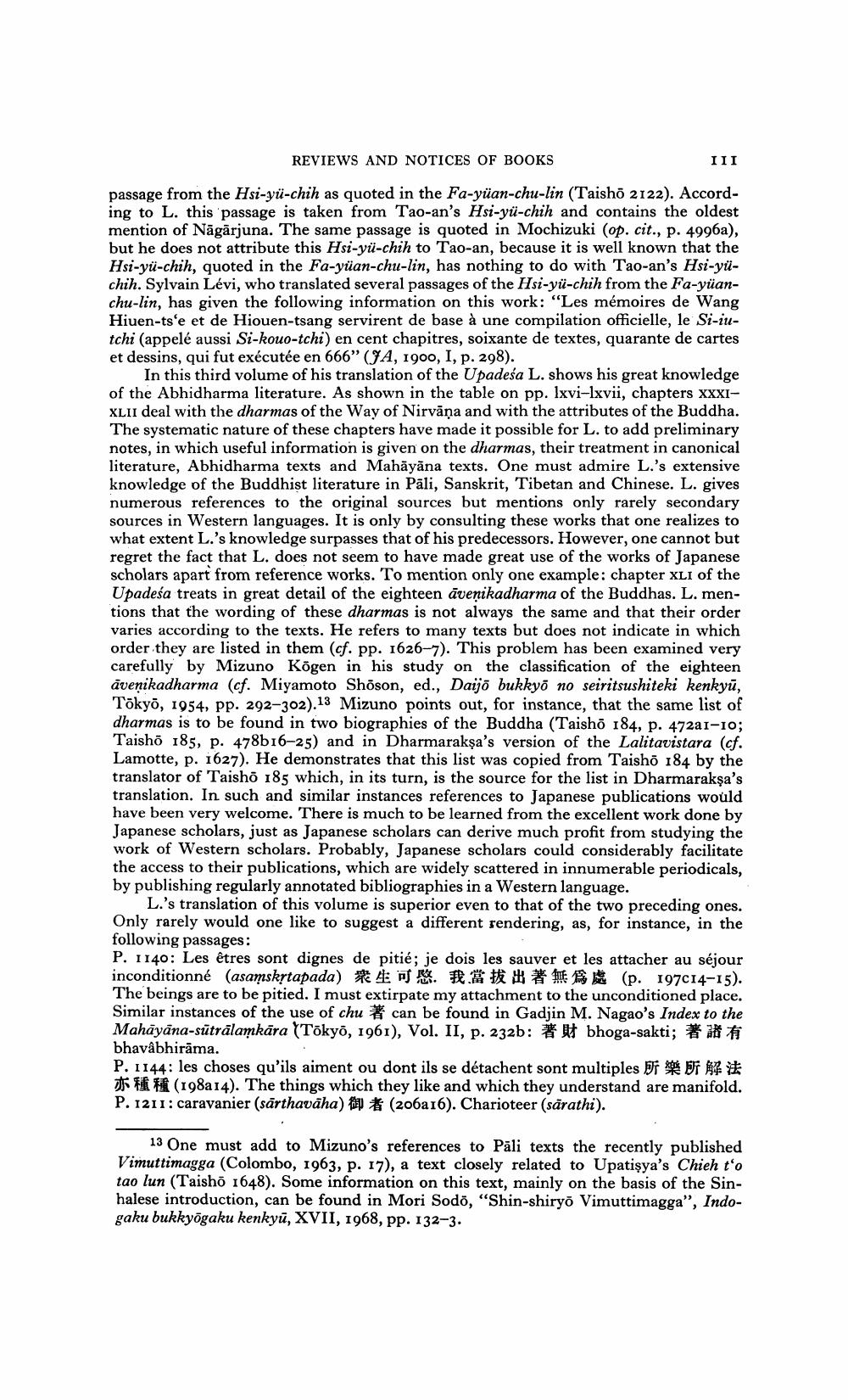________________
REVIEWS AND NOTICES OF BOOKS
III
passage from the Hsi-yü-chih as quoted in the Fa-yuan-chu-lin (Taisho 2122). According to L. this passage is taken from Tao-an's Hsi-yü-chih and contains the oldest mention of Nāgārjuna. The same passage is quoted in Mochizuki (op. cit., p. 4996a), but he does not attribute this Hsi-yü-chih to Tao-an, because it is well known that the Hsi-yü-chih, quoted in the Fa-yuan-chu-lin, has nothing to do with Tao-an's Hsi-yüchih. Sylvain Lévi, who translated several passages of the Hsi-yü-chih from the Fa-yuanchu-lin, has given the following information on this work: "Les mémoires de Wang Hiuen-ts'e et de Hiouen-tsang servirent de base à une compilation officielle, le Si-iutchi (appelé aussi Si-kouo-tchi) en cent chapitres, soixante de textes, quarante de cartes et dessins, qui fut exécutée en 666" (JA, 1900, I, p. 298).
In this third volume of his translation of the Upadeśa L. shows his great knowledge of the Abhidharma literature. As shown in the table on pp. Ixvi-lxvii, chapters XXXIXLII deal with the dharmas of the Way of Nirvāṇa and with the attributes of the Buddha. The systematic nature of these chapters have made it possible for L. to add preliminary notes, in which useful information is given on the dharmas, their treatment in canonical literature, Abhidharma texts and Mahāyāna texts. One must admire Li's extensive knowledge of the Buddhist literature in Pāli, Sanskrit, Tibetan and Chinese. L. gives numerous references to the original sources but mentions only rarely secondary sources in Western languages. It is only by consulting these works that one realizes to what extent L.'s knowledge surpasses that of his predecessors. However, one cannot but regret the fact that L. does not seem to have made great use of the works of Japanese scholars apart from reference works. To mention only one example: chapter XLI of the Upadeśa treats in great detail of the eighteen avenikadharma of the Buddhas. L. mentions that the wording of these dharmas is not always the same and that their order varies according to the texts. He refers to many texts but does not indicate in which order they are listed in them (cf. pp. 1626-7). This problem has been examined very carefully by Mizuno Kögen in his study on the classification of the eighteen ävenikadharma (cf. Miyamoto Shōson, ed., Daijo bukkyo no seiritsushiteki kenkyū,
Tokyo, 1954, pp. 292-302).13 Mizuno points out, for instance, that the same list of dharmas is to be found in two biographies of the Buddha (Taisho 184, p. 47201-10; Taisho 185, p. 478b16-25) and in Dharmarakşa's version of the Lalitavistara (cf. Lamotte, p. 1627). He demonstrates that this list was copied from Taisho 184 by the translator of Taisho 185 which, in its turn, is the source for the list in Dharmarakşa's translation. In such and similar instances references to Japanese publications would have been very welcome. There is much to be learned from the excellent work done by Japanese scholars, just as Japanese scholars can derive much profit from studying the work of Western scholars. Probably, Japanese scholars could considerably facilitate the access to their publications, which are widely scattered in innumerable periodicals, by publishing regularly annotated bibliographies in a Western language.
Li's translation of this volume is superior even to that of the two preceding ones. Only rarely would one like to suggest a different rendering, as, for instance, in the following passages: P. 1140: Les êtres sont dignes de pitié; je dois les sauver et les attacher au séjour inconditionné (asamskytapada) *An . . ## HE (p. 197014-15). The beings are to be pitied. I must extirpate my attachment to the unconditioned place. Similar instances of the use of chu can be found in Gadjin M. Nagao's Index to the Mahāyāna-sutralamkāra (Tokyõ, 1961), Vol. II, p. 232b: 8 k bhoga-sakti; # # # bhavabhirama. P. 1144: les choses qu'ils aiment ou dont ils se détachent sont multiples br br ** of H (198a 14). The things which they like and which they understand are manifold. P. 1211: caravanier (sārthavaha) Ap(206a 16). Charioteer (sārathi).
13 One must add to Mizuno's references to Pāli texts the recently published Vimuttimagga (Colombo, 1963, p. 17), a text closely related to Upatişya's Chieh t'o tao lun (Taisho 1648). Some information on this text, mainly on the basis of the Sinhalese introduction, can be found in Mori Sodo, "Shin-shiryo Vimuttimagga", Indogaku bukkyōgaku kenkyū, XVII, 1968, pp. 132-3.




